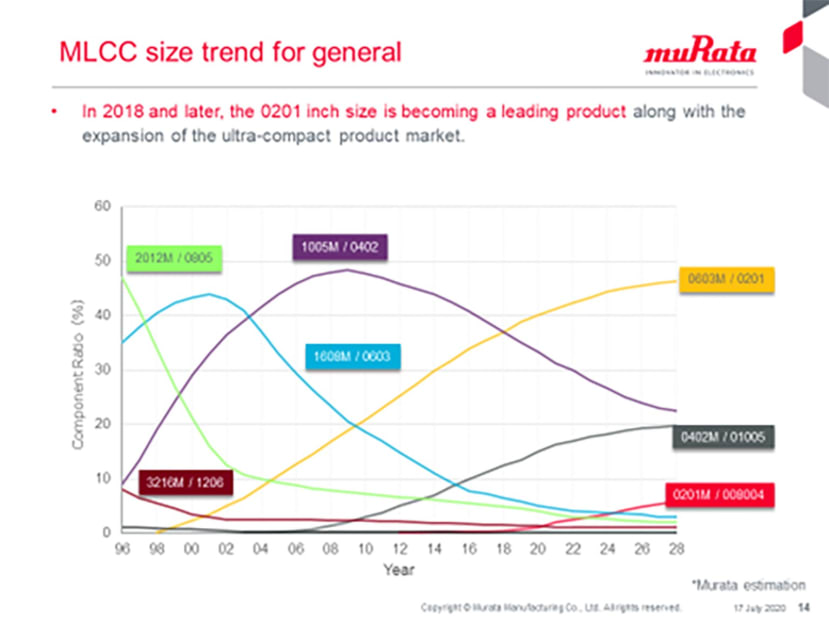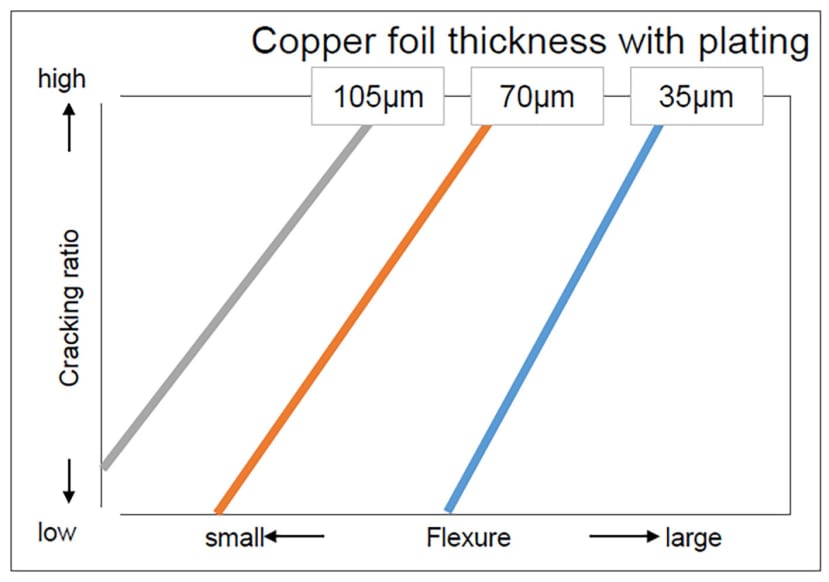Downsizing to smaller MLCCs – what you should know
Follow articleHow do you feel about this article? Help us to provide better content for you.
Thank you! Your feedback has been received.
There was a problem submitting your feedback, please try again later.
What do you think of this article?
As technology advances, smaller multilayer ceramic capacitors are becoming available with reduced size for the same headline performance. Some parameters such as DC bias and self-resonance do change however and need consideration. Board layout should also be addressed when downsizing to avoid component stress. Downsizing is however an advantage to users, not only for space-saving but also for the security of supply and cost.
Multilayer ceramic capacitors, MLCCs, are the unsung heroes of modern electronics – while the latest processor in your smartphone claims the headlines, there are typically more than a thousand MLCCs in the handset for functions ranging from coupling and decoupling to timing and filtering. There might be 10,000+ MLCCs across all of the embedded electronics in an electric vehicle (EV), so you can see that the market for the components runs into trillions per year.
The supply and demand dynamic of MLCCs have always been volatile and after a drop in demand in 2019, most likely due to stock-piling after shortages in 2018, there has been a turn-round and suppliers are racing to ramp up production again. The increased demand is being fuelled by 5G cell phones and infrastructure roll-out, where the smaller case sizes are necessary for compact end-products and in EVs and industrial, where the larger sizes are preferred for perceived better reliability under environmental stress.
0201 MLCCs dominate the market demand
The mix of MLCCs sold into the market continues to change with the ‘0201’ case size currently dominating. This is the imperial measurement, 0.02 x 0.01 inch approximately, or 0.6mm x 0.3mm. Figure 1 shows how the sales volumes have changed over the years from the world’s largest MLCC supplier, Murata.
Figure 1: Percentage production of MLCC sizes over the years from Murata
It’s important to appreciate that the graph represents the percentage mix of sizes, rather than the volume manufactured of each type. In reality, suppliers such as Murata are actually increasing their manufacturing capacity in the larger case sizes as the overall capacitor market expands. The trend towards 0201 is clear, however, for its use in high-density designs, driven by process improvements that are allowing currently up to 4.7µF at 6.3V rating for the Murata general-purpose GRM series, with an X5R dielectric. As 0201 dominates demand more and more, by moving to this size users can expect better security of supply, access to the latest fabrication technology and potential price reductions. This is facilitated by the reduced material content in the smaller sizes using finer grain ceramic powders and thinner dielectric sheets. The effect is dramatically illustrated in Figure 2, showing the number of components manufactured from approximately the same volume of material, ranging from 10 pcs for 1210 size to 3,700 for 0201 to a staggering 100,000 pcs for 008004.
Figure 2: Number of MLCCs produced in the various sizes from approximately the same material volume
Smaller case sizes have different DC bias and self-resonance characteristics
Users tempted by the possibility to downsize to 0201 with the same nominal capacitance and voltage rating can expect the advantages of easier availability and lower cost, but there are some practical issues to consider – the DC bias characteristics are likely to be different, for one. This is the effect where MLCC capacitance reduces with increased applied DC voltage with high dielectric constant (Class 2) materials such as, X5R, X6S and X7R. When 0.1µF, 10V, X7R Murata MLCCs are compared between 0402 and 0201 sizes, the larger part drops about 25% in capacitance from zero to 10V bias but the 0201, with a quarter of the footprint, drops about 70% (Figure 3). Depending on the application and cost target, a higher nominal capacitance part may need to be considered or parts in parallel may be the best solution.
Figure 3: Smaller case size affects DC bias characteristics and self-resonant frequency
The effect is largely absent in the more stable Class 1, (C0G) dielectric, with no significant capacitance change up to the full rated voltage for any case size. For both Class 1 and 2 materials, the smaller 0201 component dimensions result in lower equivalent series inductance (ESL) than for larger sizes. This is generally a good thing, with the self-resonant frequency consequently increasing by a small amount, as seen in Figure 3. However, when C0G types are used in filtering and matching applications, this may need to be allowed for.
When downsizing, tracking arrangements must be considered to avoid stress
Another consideration when downsizing to 0201 is the risk of cracking under board bending stress during PCB placement and reflow, and end-use. Small case-sizes can withstand the same stress as bigger case-sizes but due to PCB design, they are susceptible to be exposed to higher stress in general. One reason for that is the Cu-tracks width, which is basically determined by application requirements. Generally, for the same PCB track width to an MLCC along its longer length, stress on the capacitor is higher for smaller sizes so ideally, in addition to reducing land size, the width of tracks leading to the component should also be taken into consideration. Figure 4 shows a simulation of 40% more stress on the MLCC with a 0.25mm track compared with no longitudinal track or a via the connection.
Figure 4: Width of longitudinal tracking to an MLCC affects component stress with board bending. Source: Murata
Other connection arrangements can also reduce stress; for example, leading a track away from an MLCC termination at right angles to the longer dimension of the part is better, or by making the connection through a via, close to the termination. A similar effect can be seen with thicker tracks; for the same stress on MLCCs, smaller sizes should have thinner tracks. Figure 5 shows the relative sensitivity to cracking (cracking ratio) versus degree of flexure, dependent on copper foil thickness.
Figure 5: MLCC stress with board flexure varies with copper thickness
Therefore small case sizes should be handled with care. However as we can see due to rise in use and demand as well as more sophisticated & modern production technology and abilities, users are capable of handling these small case sizes and growing accustomed to these extreme small case-sizes.
Simulation tools ease MLCC selection and characterization
The electrical and mechanical system effects of changing to 0201 size MLCCs from larger types can be predicted with the help of manufacturers’ tools such as Murata’s ‘SimSurfing’ simulator. The free-to-use, web-based software allows initial selection of a part from the extensive Murata range from headline ratings of capacitance, voltage, temperature characteristics, size, tolerance and application type. Once a part is chosen, detailed characteristics and their variation can be displayed and graphed such as capacitance, impedance, equivalent series resistance, reactance, Q, dissipation factor, and equivalent series inductance. Variation of parameters with frequency, DC bias and temperature are displayed with graphs overlaid as wished. For more detailed analysis, the ‘S’ parameters ‘return loss’, (S11) and ‘forward transmission’ (S21), can also be graphed in ‘Smith chart’ format. Temperature rise with AC ripple and variation of capacitance with AC voltage superimposed can also be indicated. All graphs can be downloaded to print or raw data exported. SimSurfing is supported by comprehensive guidance notes and videos to demonstrate the use of the software.
Downsizing to 0201 MLCCs where practical in designs will keep users at the leading edge of technology in terms of volumetric performance and provide a hedge against cost increases that could follow for larger case sizes as they become relatively less popular. Some electrical considerations such as DC bias derating must be considered and PCB tracking should be addressed to maintain reliability with board flexure. However, better product performance can result from the change to 0201 MLCCs, assisted by manufacturers such as Murata with their comprehensive product portfolio, application data and simulation tools.






